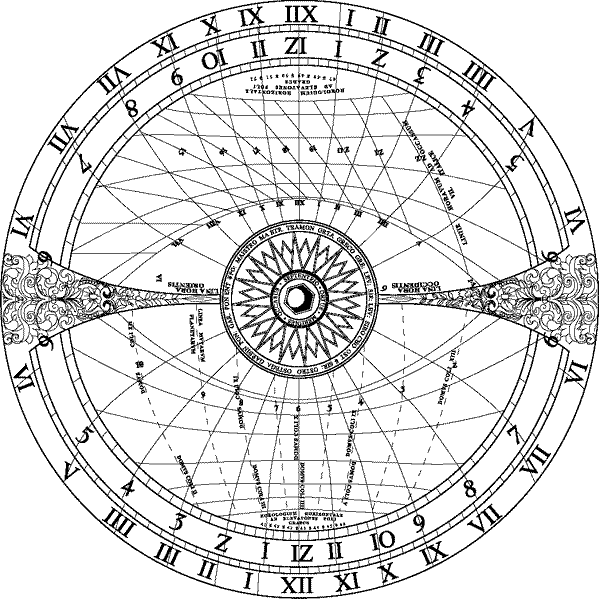What is the Horologium?

The American Philosophical Society has little or nothing to do with philosophy. It was founded centuries ago before science was called science and was called “natural philosophy. It is, therefore, really the American Scientific Society and holds many treasures of historical achievements in science of American invention.
On the second floor, in a glass door cabinet near a window, are two brass and gold-plated bowls, one 12 inches in diameter and the other 5 3/4” in diameter. They were once connected by a piece that’s been lost forever. The larger bowl sat concavely on top, the smaller convexly. Mounted on the rim of the larger bowl is a 3 3/4” figure of a Moor or Arabic man with a turban holding a staff.
The curators call it the Schissler dial—Christopher Schissler being the name of craftsman whose foundry fashioned it in Germany in 1578, and “dial” referring to its use as a sundial. However, it calls itself by a much more colorful name, the Horologium Achaz Hydrographicum. But what does that mean? Let’s take it apart wordy by word.
The words are, of course, Latin. Horologium suggests it is a device for time-keeping, a sundial.
Achaz was the 11th king of Judah. In 771 BC he had a sundial fashioned for himself. It is the first one is mentioned in western literature. The son and heir of Achaz was named Hezikiah. According to the 38th chapter of the biblical book of Isaiah, as King Hezikiah lay sick and dying, he prayed that he might be spared. So God sent the prophet Isaiah to tell the king he would give him an extra 15 years to live, and just to prove it, he would turn back time. So indeed it came to pass, and Hezikiah was astonished when he looked out of his window on the sundial, which bore the name of his father, and saw the shadow marking the time move backwards by 10 degrees which is forty minutes. So the Dial of Achaz was the instrument of an astounding miracle that occurred 1,200 years before the instrument that bears its name was made. The word Hydrographicum suggests “writing by water” or “writing in water.” On the bottom or concave side of the smaller of the two bowls are two charts that pertain to the latitude of the user of the sundial, two sketches and the following inscription in Latin:
"This semicircular shell explains the miracle of the 38th chapter of Isaiah. For if you fill the basin full with water, the shadow of the sun is borne backward by ten degrees. Moreover, it indicates any common hour of the day whatever, together with that of the planets which they call hours."
And, it delivers what it says. In the 1970s a group of scientists took the device from its home in the cabinet in the American Philosophical Society, put it out on the lawn of Independence Mall, set it up as a sundial, and filled the bowl with water, — and witnessed the shadow marking the time go backward by 10 degrees-- exactly the forty minutes of the miracle of Isaiah.
So the instrument is, in a sense, a time machine.
We all know how it works. It is due to the law of refraction—the principle that explains why a stick looks bent when it’s halfway under water in a clear pool. Only there’s something interesting about this: the first time the law of refraction was delineated in western scientific literature was by Willebrord Snellius in the 1620s, over forty years after the creation of the Horologium Achaz Hydrographicum.
Was Christopher Schissler, the craftsman, a physicist who was ahead of his time, a man who simply intuitively grasped the laws of nature, or did he have access to a body of knowledge that his contemporaries didn’t? This is only one of the questions we’re faced with.
Was our timekeeping device simply a novelty? Here’s one possible clue:
The noted 18th century traveler and chronicler Zacharias von Uffenbach apparently came across someone who knew about this device. He wrote about it twice in his memoirs. One reference seems to have been stricken from the text—not without good cause—that the reason for this, and the reason for the bowl’s trick—was to tie the instrument to a Biblical story, thus diverting attention from its real use as an astronomical—and therefore heretical—device. If you recall your history, you’ll remember the trouble that Galileo, Copernicus and Kelplar got into during the same century.
So what might those other uses have been? The markings on the upper bowl suggest a more complicated geometry than simply keeping track of the hours of the day.
Around the rim of the upper bowl are reliefs of the familiar zodiacal signs: the goat, the crab, the centaur, etc. It is very possible that the Horologium was used in the casting of horoscopes. This explains why oral tradition has it, according to Julius Sachse, that by using the instrument it’s user could know not only the hour of the day by sun, but also the hour of the night by the moon, the position of the planets, sun, and moon in the houses of the zodiac, the sun’s perigee and apogee, its height above the horizon, the length of the day, and perhaps much more.
We will remember that astrology was still part of the mainstream of both religious and scientific endeavors at the time the instrument was crafted. There is an oral tradition that connects the device with Johann Jacob Zimmerman, a famous German astronomer who was reputedly a member of the Royal Society of London, was a man who was deeply interested in both subjects, as well as astrology. But it is very unlikely that a man of Zimmerman’s achievements in astronomy—his ability to predict comets for instance—would use such a sophisticated device merely for astrology.
But how did Zimmerman, who lived a hundred years after the craftsman Christopher Schissler, obtain the instrument and learn how to use it? As we in the twenty-first century can’t figure it out, it either came with an interesting instruction booklet, or more likely, the secret was passed from master to disciple.
There’s simply no way of knowing that or where the Horologium was for a hundred years. Christopher Schissler was a craftsman of some repute. He called himself a Geometer and an Astronomer. He created many other interesting sundials and devices, but no one has been able to find a trace or even a suggestion that he made anything else like the Horologium. We can only assume that the instrument was obtained only at tremendous time, effort, and expense. It might be safe to assume that it was in its day the equivalent of the Hubble Space Telescope. And from what we know of Zimmerman, he wasn’t a man of unlimited means.
And for what reason did he have it, assuming he did? For scientific research? Probably. For the casting of horoscopes? Maybe. For some occult endeavor? Possibly.
There are other questions that we are left with. Why the figure of Arabic man? We know that for centuries the Arabic world was the repository of knowledge of astronomy and mathematics. They might have also fully understood the principles of refraction.
One other thing: the Islamic world was the ultimate source of mystical and so-called occult knowledge in medieval Europe. Was there a connection between the culture suggested by the figure and mystical societies in 16th century Germany?
And now for the last mystery. How did such a thing end up in a cabinet in a museum in Philadelphia? The fact is that no one knows how it got there. There are no records of the device every being acquired by the institution, nor any records of anyone donating it.
It is part of the story of Kelpius that he was interested in astronomy. It is said that the Kelpius Community had one of the country’s first telescopes that were used to search and note celestial movements from a tower.
Kelpius was a student, and follower, of Johann Jacob Zimmerman, the noted astronomer.
In the early 18th century, the Englishman named Christopher Witt likely fell heir to the artifacts of the Kelpius Community after it disbanded. Christopher Witt in his old age became acquainted with a bright young man from Philadelphia named Benjamin Franklin who, as you might or might not know, founded the American Philosophical Society.
This, like almost everything connected with the Horologium Achaz Hydrographicum, is speculation. But they are all educated guesses and they all combine to make an intriguing and fascinating story that rivals anything Dan Brown has written.
Above: Image of the engraving on the bowl of the Schissler Dial. Courtesy of The American Philosophical Society.

